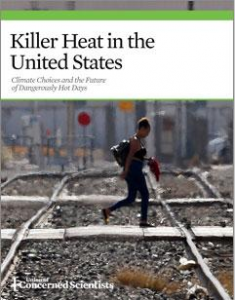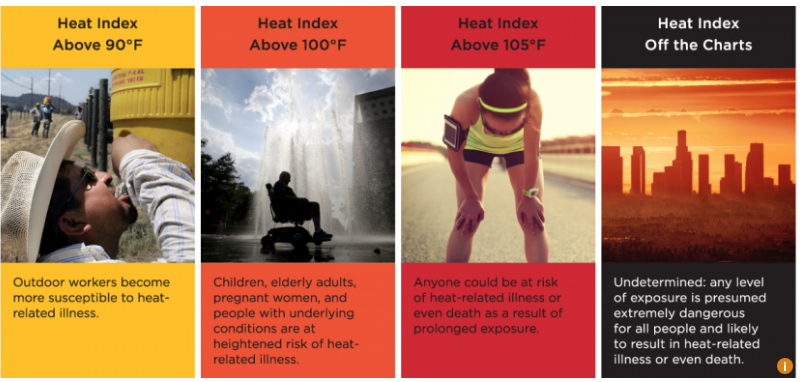Increases in potentially lethal heat driven by climate change will affect every state in the contiguous U.S. in the decades ahead, according to a new report and accompanying peer-reviewed study in Environmental Research Communications, both by the Union of Concerned Scientists. Few places would be unaffected by extreme heat conditions by midcentury and only a few mountainous regions would remain extreme heat refuges by the century’s end.
Without global action to reduce heat-trapping emissions, the number of days per year when the heat index— or “feels like” temperature — exceeds 100 degrees Fahrenheit would more than double from historical levels to an average of 36 across the country by midcentury and increase four-fold to an average of 54 by late century.
The average number of days per year nationwide with a heat index above 105 degrees Fahrenheit would more than quadruple to 24 by midcentury and increase eight-fold to 40 by late century.

The analysis, titled Killer Heat in the United States: Climate Choices and the Future of Dangerously Hot Days shows a hotter future that’s hard to imagine today.
Nearly everywhere, people will experience more days of dangerous heat even in the next few decades. By the end of the century, with no action to reduce global emissions, parts of Florida and Texas would experience the equivalent of at least five months per year on average when the “feels like” temperature exceeds 100 degrees Fahrenheit, with most of these days even surpassing 105 degrees. On some days, conditions would be so extreme that they exceed the upper limit of the National Weather Service heat-index scale and a heat index would be incalculable. Such “off-the-charts” conditions could pose unprecedented health risks.
The analysis calculated the frequency of days with heat index thresholds above 90 degrees Fahrenheit — the point at which outdoor workers generally become susceptible to heat-related illness — as well as above 100 and 105 degrees Fahrenheit, when the National Weather Service (NWS) generally recommends issuing heat advisories and excessive heat warnings, respectively.
The number of high heat-index days was calculated by averaging projections from 18 high-resolution climate models between April and October. The report looked at these conditions for three possible futures.
The “no action scenario” assumes carbon emissions continue to rise and the global average temperature increases nearly 4.3 degrees Celsius (about 8 degrees Fahrenheit) above pre-industrial levels by century’s end. The “slow action scenario” assumes carbon emissions start declining at midcentury and the global average temperature rises 2.4 degrees Celsius (4.3 degrees Fahrenheit) by century’s end. In the “rapid action scenario,” global average warming is limited to 2 degrees Celsius (3.6 degrees Fahrenheit)—in line with the Paris Agreement.
The analysis also examined the number of people in each state that would be exposed to a heat index above 90 degrees Fahrenheit, 100 degrees Fahrenheit, 105 degrees Fahrenheit, or off-the-charts conditions for an average equivalent of at least one week, one month, or two months per year. All population data presented here, including for future projections, is based on the most recent U.S. Census conducted in 2010 and does not account for population growth or changes in distribution.
The U.S. Southeast region, as defined by the latest U.S. National Climate Assessment, would be the hardest hit seeing an average of 96 days per year with a heat index above 100 degrees Fahrenheit, 73 days per year with a heat index above 105 degrees Fahrenheit and 12 “off-the-charts” days per year by the end of the century if no action is taken to reduce global warming emissions, with Florida, Louisiana and Mississippi seeing the largest rise in extreme heat.
Here are the sobering results for Kentucky, assuming no global action to reduce emissions, are below.
Kentucky
• Historically, there have been 41 days per year on average with a heat index above 90 degrees Fahrenheit, the worker safety threshold. This would increase to 91 days per year on average by midcentury and 120 by the century’s end.
• Historically, there have been six days per year on average with a heat index above 100 degrees Fahrenheit. This would increase to 45 days per year on average by midcentury and 76 by the century’s end. Of the cities with a population of 50,000 or more in the state, Bowling Green, Louisville and Owensboro would experience the highest frequency of these days. Limiting warming to 2 degrees Celsius above pre-industrial could cap the frequency of such days at an average of 33 per year.
• By the end of the century, an estimated 4.2 million people would be exposed to a heat index above 100 degrees Fahrenheit for the equivalent of two months or more per year. By limiting warming to 2 degrees, Celsius nearly all residents would avoid such days of extreme conditions.
• Historically, there has been an average of one day per year with a heat index above 105 degrees Fahrenheit. This would increase to 26 days per year on average by midcentury and 55 by the century’s end. Limiting warming to 2 degrees Celsius above pre-industrial levels would cap the frequency of such days at an average of 17 per year.
• By the end of the century, an estimated 4.3 million people would be exposed to a heat index above 105 degrees Fahrenheit for the equivalent of a month or more per year. By limiting warming to 2 degrees Celsius, more than 4 million of those residents would avoid such days of extreme conditions.
• Historically, the state as a whole has experienced zero “off-the-charts” heat days in an average year. This would increase to two days per year on average by midcentury and 10 by the end of the century. Limiting warming to 2 degrees Celsius would cap the frequency of such days at an average of one per year.
• By the end of the century, an estimated 3.4 million people would endure “off-the-charts” heat days for the equivalent of a week or more per year. Historically, fewer than 2,000 people nationwide have experienced such conditions in an average year. By limiting warming to 2 degrees Celsius, all residents would avoid such days of extreme conditions.
The Union of Concerned Scientists


















“Climate change” is happening extremely slowly, at a earth’s natural pace. It is not caused by humans.
Case in point – Go to most any coastal city and you will witness billions of dollars worth of buildings being built on the seas edge. Why? Because the ocean levels are not rising and won’t rise any time soon. The banks and the government knows it. Otherwise builders wouldn’t be able to get financing from banks and are ultimately regulated by the government.
If the sea levels and temps were actually rising the banks wouldn’t finance otherwise they’d be bankrupt in a matter of years with buildings under water according to loony environmentalists fake prediction of sea level rise of feet in less than a decade.
Tough to argue against that one, unless your a sheep and really don’t put actual thought towards it.
It went from “global warming” to “climate change”. Why? Because the planet is not warming, the leaders of the loonies know it, so they changed the name so it’s not as questionable when science and time prove nearly all of the predictions completely wrong.
Now it’s time for the loonies to call me a racist and sexist because i used logic and shared an opinion that isn’t completely in line with theirs.